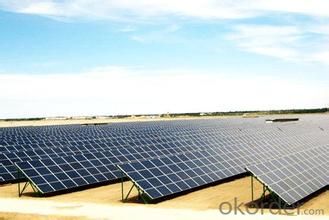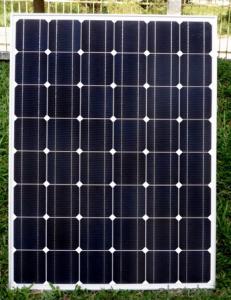25W CNBM Monocrystalline Silicon Panel for Home Using
- Loading Port:
- Tianjin
- Payment Terms:
- TT OR LC
- Min Order Qty:
- 100 watt
- Supply Capability:
- 1000 watt/month
OKorder Service Pledge
OKorder Financial Service
You Might Also Like
Item specifice
25W CNBM Monocrystalline Silicon Panel for Home Using
Production description
while the rest of the overall market is made up of thin-film technologies using cadmium telluride, CIGS and amorphous silicon[7]Emerging, third generation solar technologies use advanced thin-film cells. They produce a relatively high-efficiency conversion for the low cost compared to other solar technologies. Also, high-cost, high-efficiency, and close-packed rectangular multi-junction (MJ) cells are preferably used in solar panels on spacecraft, as they offer the highest ratio of generated power per kilogram lifted into space. MJ-cells are compound semiconductors and made of gallium arsenide (GaAs) and other semiconductor materials. Another emerging PV technology using MJ-cells is concentrator photovoltaics (CPV).

Feature
1.High conversion efficiencies resulting in superior power output performance.
2.Outstanding power output even in low light or high temperature conditions
3.Optimized design for ease of soldering and lamination
Physical characteristic
1. Rigorous quality control meets the highest international standards.
2. High-transmissivity low-iron tempered glass, strong aluminium frame.
3. Using UV-resistant silicon.
4. IS09001/14001/CE/TUV/UL
- Q:Can solar panels be installed on a hospital or medical facility?
- Yes, solar panels can be installed on a hospital or medical facility. Solar panels can help hospitals and medical facilities reduce their electricity costs and reliance on the grid, while also promoting clean and sustainable energy.
- Q:Can solar panels be used to power swimming pools?
- Yes, solar panels can indeed be used to power swimming pools. Solar panels can generate electricity from sunlight, which can be used to operate pool pumps, heaters, and other equipment, reducing the reliance on traditional electricity sources and saving on energy costs.
- Q:Can solar panels be used in areas with high levels of UV radiation?
- Yes, solar panels can be used in areas with high levels of UV radiation. In fact, they are designed to withstand and harness UV rays from the sun to generate electricity. The materials used in solar panels are specifically chosen to endure high UV exposure, ensuring their efficiency and longevity even in such conditions.
- Q:K i'm almost ready to give up! I've bought every kind of pv I can think of, and I can see this technology will not be affordable in my lifetime.I conserve all I can (so far as to handwashing my laundry etc) I'm not rich, but I'm saving for a solar pv with decent amperage. I love tinkering with things if I see the point.All the cells i've seen are very weak. What PV would you buy? (all I need is to power my computer from a deep cycle 2 volt battery connected to an inverter)God Bless You
- Solar okorder /
- Q:How much would it cost to make an average size house be able to depend on solar panels for all of its power?How many solar panels would you need and wear would you put them? Would the roof be large enough to support the panels needed?Do solar panels work well in higher latitudes like northern USA or southern Canada? Can you power your house for the whole year if you live in these environments? What kind of maintenance do solar panels require?
- There are several web sites you can search for and they will provide the answer on how big of a PV Solar Array you would need for your house. Several things need to be known, such as square footage of the home, how well the home is insulated, etc. The panels come in all sizes and wattage's depending upon application, so yes they should all fit on the roof. If you have a small roof get PV panels with higher wattage's. Yes, they will work in the northern latitudes but not as efficiently as near the equator. You might need more PV panels to make up the loss in power from the sun hitting at a lower angle. Generally, all you will need to do is periodically clean the glass covering of the PV Panels to get maximum sun light on the PV cells. In my region, near the 45 th parallel, a 600 square foot home with six inch insulated walls and R40 attic insulation can purchase a PV panel system for around $40,000. That includes the equipment to tie it into the power grid and the meter to measure how much you supply the grid during the day and how much you draw from the grid at night when the sun isn't shining. There are tax credits for retrofitting an existing home, but mostly it is new homes being built that are having the PV panel systems installed so the cost is added to the mortgage and the return on the investment is paid off over the life of the System (about 5 to 20 yrs.)
- Q:Can solar panels be installed in areas with high humidity?
- Yes, solar panels can be installed in areas with high humidity. While humidity can slightly affect the efficiency of solar panels, it does not prevent their installation or operation. Modern solar panel technology is designed to withstand various environmental conditions, including high humidity, and they can still generate electricity even in humid environments.
- Q:Can solar panels be used for large-scale power generation?
- Yes, solar panels can definitely be used for large-scale power generation. As technology has advanced, the efficiency and capacity of solar panels have greatly improved, making them a viable option for generating significant amounts of electricity. In fact, many countries and companies are already utilizing solar farms and large-scale installations to harness the power of the sun and contribute to their energy needs.
- Q:How much energy can a solar panel produce in a day?
- The amount of energy a solar panel can produce in a day depends on various factors such as the size and efficiency of the panel, the location and angle of installation, weather conditions, and sunlight availability. On average, a typical solar panel can generate between 4 to 6 kilowatt-hours (kWh) of electricity per day. However, this can vary significantly, and larger, more efficient panels in optimal conditions can produce even more energy.
- Q:What are the different types of solar panels?
- There are primarily three types of solar panels: monocrystalline, polycrystalline, and thin-film solar panels. Monocrystalline panels are made of a single crystal structure, making them highly efficient but also more expensive. Polycrystalline panels are made up of multiple crystals and are slightly less efficient but more affordable. Thin-film panels are the least efficient but are flexible and can be used in a variety of applications.
- Q:For my Product Design Coursework I am designing an environment friendly building according to a clients' specifications. I need to find out the dimensions of 0000 watt solar panels. any help would be much appreciated!
- About 2500 Sq. Yd.s
1. Manufacturer Overview |
|
|---|---|
| Location | |
| Year Established | |
| Annual Output Value | |
| Main Markets | |
| Company Certifications | |
2. Manufacturer Certificates |
|
|---|---|
| a) Certification Name | |
| Range | |
| Reference | |
| Validity Period | |
3. Manufacturer Capability |
|
|---|---|
| a)Trade Capacity | |
| Nearest Port | |
| Export Percentage | |
| No.of Employees in Trade Department | |
| Language Spoken: | |
| b)Factory Information | |
| Factory Size: | |
| No. of Production Lines | |
| Contract Manufacturing | |
| Product Price Range | |
Send your message to us
25W CNBM Monocrystalline Silicon Panel for Home Using
- Loading Port:
- Tianjin
- Payment Terms:
- TT OR LC
- Min Order Qty:
- 100 watt
- Supply Capability:
- 1000 watt/month
OKorder Service Pledge
OKorder Financial Service
Similar products
New products
Hot products




























